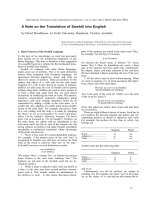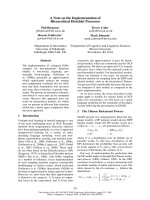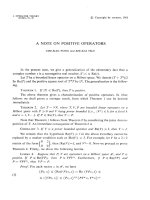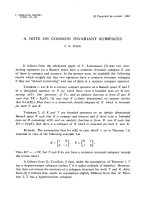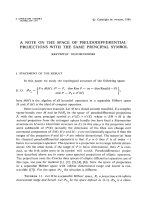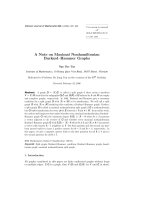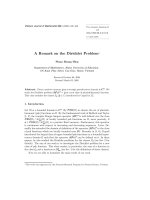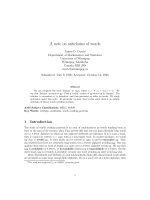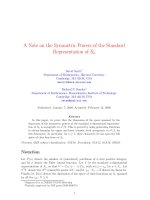Báo cáo toán học: "A note on the component structure in random intersection graphs with tunable clustering" pptx
Bạn đang xem bản rút gọn của tài liệu. Xem và tải ngay bản đầy đủ của tài liệu tại đây (123.99 KB, 8 trang )
A note on the component structure in random
intersection graphs with tunable clustering
Andreas N. Lager˚as
∗
Mathematical Sciences and Centre for Theoretical Biology,
Chalmers University of Technology and G¨oteborg University, 412 96 Gothenburg, Sweden
Mathias Lindholm
†
Department of Mathematics, Stockholm University, 106 91 Stockholm, Sweden
Submitted: Sep 10, 2007; Accepted: Apr 4, 2008; Published: Apr 10, 2008
Mathematics Subject Classification: 05C80
Abstract
We study the component structure in random intersection graphs with tunable
clustering, and show that the average degree works as a threshold for a phase tran-
sition for the size of the largest component. That is, if the expected degree is less
than one, the size of the largest component is a.a.s. of logarithmic order, but if the
average degree is greater than one, a.a.s. a single large component of linear order
emerges, and the size of the second largest component is at most of logarithmic
order.
1 Introduction
The random intersection graph, denoted G
(n)
m,p
, with a set of vertices V = {v
1
, . . . , v
n
} and
a set of edges E is constructed from a bipartite graph B
(n)
m,p
with two sets of vertices: V,
identical to those of G
(n)
m,p
, and A = {a
1
, . . . , a
m
}, which we call auxiliary vertices. Edges in
B
(n)
m,p
between vertices and auxiliary vertices are included independently with probability
p ∈ [0, 1]. An edge between two vertices v
i
and v
j
in G
(n)
m,p
is only present in E if both v
i
and v
j
are adjacent to some auxiliary vertex a
k
in B
(n)
m,p
. Along the lines of Karo´nski et
al. [5] we set m := βn and p := γn
−(1+α)/2
, where α, β, γ ≥ 0, to obtain an interesting
graph structure and bounded average vertex degree. For random (multi)graphs, the vertex
degree distribution is defined as the distribution of the degree, i.e. the number of adjacent
∗
supported by the Faculty of Science, G¨oteborg University.
†
supported by the Swedish Foundation for Strategic Research (SSF).
the electronic journal of combinatorics 15 (2008), #N10 1
edges, of a vertex chosen uniformly at random. As has been shown by Stark [7], the vertex
degree distribution of the random intersection graph is highly dependent on the value of
α, but as shown by Deijfen and Kets [3], the clustering is tunable only when α ≡ 1. In a
recent paper by Behrisch [2], the component structure of the random intersection graph is
studied for α = 1 and β = 1, and the aim of the present note is to describe the component
structure when α = 1. We will henceforth keep β and γ fixed and positive, and sometimes
suppress the dependency on these parameters in the notation: G
(n)
.
2 The degree distribution
We define D(m, n, p) to be a random variable with the vertex degree distribution of the
graph G
(n)
m,p
. Stark [7, Thm. 1] showed that the distribution of D(m, n, p) has the following
generating function
g
D(m,n,p)
(z) := E
z
D(m,n,p)
=
n−1
j=0
n − 1
j
z
j
(1 − z)
n−1−j
1 − p + p (1 − p)
n−1−j
m
.
This distribution is from here onwards denoted RIG(m, n, p). Let us define a certain
compound Poisson random variable Z by its generating function
g
Z
(s) := E
s
Z
= exp
λ
e
λ
(s−1)
− 1
,
and write Z ∈ CPoisson(λ
, λ
). Here E[Z] = λ
λ
. Another result by Stark [6, Thm. 2],
here slightly generalised, is
Lemma 1. If n
and n
are functions of n such that βn ≥ n
, n
/n = β + o(1), n ≥ n
,
n
/n = 1 + o(1), then D(n
, n
, γ/n)
d
→ CPoisson(βγ, γ) as n → ∞.
This can be shown by inspecting the generating functions. In particular
E[D(m, n, p)] = g
D(m,n,p)
(1) = (n − 1)[1 − (1 − p
2
)
m
]
E[D(m, n, p)(D(m, n, p) − 1)] = g
D(m,n,p)
(1)
= (n − 1)(n − 2)[1 − 2(1 − p
2
)
m
+ (1 − p
2
(2 − p))
m
],
and with n
and n
as in the lemma we can deduce E[D(n
, n
, γ/n)] = µ + o(1) = O(1),
where µ := βγ
2
, and E[D(n
, n
, γ/n)
2
] = µ(1 + µ + γ) + o(1) = O(1). We write
g(s) := exp
βγ
e
γ(s−1)
− 1
for the generating function of the limiting distribution CPoisson(βγ, γ). Finally, let us
define ρ to be the smallest non-negative root of ρ = g(ρ).
the electronic journal of combinatorics 15 (2008), #N10 2
3 Results
Theorem 2. Let µ := βγ
2
, i.e. the asymptotic expected degree of a randomly chosen
vertex of G
(n)
.
(i) If µ < 1, then there is a.a.s. no connected component in G
(n)
with more than O(log n)
vertices.
(ii) If µ > 1, then 0 < ρ < 1 and there exists a unique giant component of size (1 −ρ +
o
p
(1))n, and the size of the second largest connected component is a.a.s. no larger
than O(log n).
With W
n
= o
p
(a
n
) we mean that W
n
/a
n
→ 0 in probability as n → ∞. As mentioned
in the introduction, Behrisch has investigated the component structure for the random
intersection graph when α = 1, see [2, Thm. 1]. It is worth noting that the results in
Theorem 2 in this note are closer to the results that Behrisch obtained for the case α > 1,
than for α < 1. For α < 1 the size of the giant component is no longer linear in n.
4 Proof of Theorem 2
For the remainder of this note we will follow the notation and steps of the proof of
Theorem 5.4 in [4, Ch. 5.2]. Therefore most of the details that have not been altered from
the original proof will be omitted. The proof is based on choosing a vertex at random
from V, say v, and exploring its component, say C(v). We start by visiting the chosen
vertex v and identifying its neighbours. Then we proceed by visiting an identified but
unvisited vertex, if any remains, and identify its neighbours, and repeat this procedure
until all vertices in the component have been visited. Let X
i
denote the number of newly
identified vertices at the ith step of this exploration process. The event {|C(v)| = k} is
equivalent to
k
i=1
X
i
= k − 1, and it is thus important to understand the growth of this
partial sums process. The random variables X
1
, X
2
, . . . are not i.i.d. but the partial sums
process can nevertheless be related to other partial sums processes with i.i.d. summands
so that we obtain bounds on events of the type above. We will need the following result
for these partial sums processes.
Lemma 3. Let δ > 0 and
˜
X :=
˜
X
1
+ ···+
˜
X
k
, where
˜
X
1
, . . . are i.i.d. as D(n
, n
, γ/n)
of Lemma 1. Then, for large enough n, there exists a positive constant C := C(β, γ, δ)
such that P(
˜
X ≥ (1 + δ)µk) ≤ e
−Ck
and P(
˜
X ≤ (1 − δ)µk) ≤ e
−Ck
.
Remark. This bound on the tail probabilities works since
˜
X is a sum of k independent
random variables. As n → ∞, the RIG-distribution of the summands does not change
much: It is more or less CPoisson(βγ, γ), which is a “well behaved” distribution, and as
k increases, we expect an exponential decay of probabilities away from the mean of the
sum. Since C is not further specified, this bound is only useful as k tends to infinity,
which it may or may not do as a function of n.
the electronic journal of combinatorics 15 (2008), #N10 3
Before we prove the lemma, note that we can construct a multigraph H
(n)
m,p
from the
same bipartite graph B
(n)
m,p
as we used in the construction of G
(n)
m,p
, by letting the number of
edges between v
i
and v
j
equal the number of auxiliary vertices a
k
that are adjacent to both
v
i
and v
j
. We denote with RIMG(m, n, p) the degree distribution of H
(n)
m,p
. RIMG(m, n, p)
clearly dominates RIG(m, n, p), as we can obtain G
(n)
m,p
from H
(n)
m,p
by coalescing multiple
edges between vertices into one single edge. RIMG(m, n, p) is a compound binomial
distribution with generating function
h(z) = (1 − p + p(1 − p + pz)
n−1
)
m
,
since, by construction, a vertex v
i
∈ H
(n)
m,p
is connected to a Binomial(m, p) number of
auxiliary vertices, each of which being connected to an independent Binomial(n − 1, p)
number of vertices in V \{v
i
}.
The expected value of RIMG(βn, n, γ/n) is thus βn(n −1)γ
2
/n
2
= µ + O(1/n) =
E[D(βn, n, γ/n)] + O(1/n), so the expected difference in vertex degree between the
multigraph and the ordinary graph is only O(1/n). With η
(n)
defined as the difference in
the total number of edges in H
(n)
βn,γ/n
and G
(n)
βn,γ/n
, we have E[η
(n)
] = O(1), by summing
over all vertices. This will be used in the proof of Theorem 2(ii).
Proof of Lemma 3. Note that E[e
θ
˜
X
] = E[e
θ
˜
X
1
+···+θ
˜
X
k
] = E[e
θ
˜
X
1
]
k
. Let s > 0. We have
P(
˜
X ≤ (1 − δ)µk) = P(e
−s
˜
X
≥ e
−s(1−δ)µk
)
≤ e
s(1−δ)µk
E[e
−s
˜
X
] =
e
sµ−sδµ
E[e
−s
˜
X
1
]
k
, (1)
P(
˜
X ≥ (1 + δ)µk) = P(e
s
˜
X
≥ e
s(1+δ)µk
)
≤ e
−s(1+δ)µk
E[e
s
˜
X
] =
e
−sµ−sδµ
E[e
s
˜
X
1
]
k
, (2)
by Markov’s inequality. Since e
−s
˜
X
1
≤ 1 − s
˜
X
1
+
1
2
s
2
˜
X
2
1
for s > 0,
E[e
−s
˜
X
1
] ≤ 1 − sE[
˜
X
1
] +
1
2
s
2
E[
˜
X
2
1
] = exp{log(1 −sE[
˜
X
1
] +
1
2
s
2
E[
˜
X
2
1
])}
= exp{−sE[
˜
X
1
] + O(s
2
)} = exp {−s (µ + o(1) + O(s))}.
The right hand side of (1) is thus exp {−s (δµ + o(1) + O(s)) k}, and we can fix a small
s, such that for large enough n, s(δµ + o(1) + O(s)) is positive (regardless of the value of
k), and thus P(
˜
X ≤ (1 − δ)µk) ≤ e
−C
k
for some positive C
.
For the second part of the proof, let
ˆ
X ∈ RIMG(n
, n
, γ/n), so that
ˆ
X ≥
d
˜
X
1
.
E[e
s
˜
X
1
] ≤ E[e
s
ˆ
X
] =
1 −
γ
n
+
γ
n
1 −
γ
n
+
γ
n
e
s
n
−1
n
< exp
γ
n
n
e
γ
n
−1
n
(e
s
−1)
− 1
= exp
γ(β + o(1))
e
γ(1+o(1))s(1+O(s))
− 1
= exp
γβ(1 + o(1))
e
γs(1+o(1)+O(s))
− 1
= exp {µs(1 + o(1) + O(s))}.
the electronic journal of combinatorics 15 (2008), #N10 4
The right hand side of (2) is thus less than exp{−s(δµ + o(1) + O(s))k}, and we can fix
a small s, such that for large enough n, s(δµ + o(1) + O(s)) is positive (regardless of the
value of k), and thus P(
˜
X ≥ (1 + δ)µk) ≤ e
−C
k
for some positive C
. We conclude the
proof of the lemma by letting C = min{C
, C
}.
Proof of Theorem 2(i). The process of exploring vertices that was briefly described in the
beginning of Section 4, implies that X
1
, the number of neighbours of the initially picked
vertex, has distribution RIG(βn, n, γ/n). This, together with the fact that vertices only
can be newly identified once, implies that
k
i=1
X
i
≤
d
k
i=1
X
+
i
for all k, where X
+
1
, . . .
are i.i.d. RIG(βn, n, γ/n). Thus
P(∃i : |C(v
i
)| ≥ k) ≤
n
i=1
P (|C(v
i
)| ≥ k) = nP (|C(v)| ≥ k) ≤ nP
k
j=1
X
+
j
≥ k − 1
.
Now we take k := k(n) increasing to infinity with n. Since all X
+
i
are i.i.d.
RIG(βn, n, γ/n), Lemma 3 applies to X
+
:=
k
j=1
X
+
j
, which gives us
P(∃i : |C(v
i
)| ≥ k) ≤ nP
X
+
≥ k − 1
= nP(X
+
≥ (1 + 2δ)µk − 1)
≤ nP(X
+
≥ (1 + δ)µk) ≤ n exp{−Ck},
where µ < 1, δ = (1/µ − 1)/2 > 0, C is defined as in Lemma 3, and the penultimate
inequality follows from δµk > 1 for large enough k. That is, if k(n) := (1 + ) log n/C,
> 0, then P(∃i : |C(v
i
)| ≥ k) ≤ n
−
→ 0 as n → ∞, and the first part of Theorem 2 is
proved.
Proof of Theorem 2(ii). We will first show that there with probability tending to one are
no clusters of size k with O(log n) = k
−
(n) ≤ k ≤ k
+
(n) := n
2/3
. From now on, let
k
−
≤ k ≤ k
+
, where k
−
(n) will be specified shortly. The construction used in the proof is
similar but more involved than the one of the first part of the proof.
For the remainder of the proof we will implicitly condition on the event {η
(n)
≤
√
n},
whose probability tends to one when n → ∞, by Markov’s inequality and the fact that
E[η
(n)
] = O(1). Our construction fails on the complementary event, but this is of no
consequence for the proof, since the probability of this event tends to zero.
Let A(v) be the event that the exploration process, initiated at v, at step k
+
has not
terminated and that it at that step has identified fewer than (µ−1)k
+
/2 vertices that have
not yet been visited, i.e. A(v) = {k
+
≤
k
+
j=1
X
j
≤ k
+
− 1 + (µ − 1)k
+
/2}. Let B(v) be
the event {
k
+
j=1
X
j
≤ k
+
−1 + (µ −1)k
+
/2}. We will prove that the probability that the
exploration process terminates after k steps or that A(v) holds for some v, tends to zero.
Note that {|C(v)| = k} ⊆ B(v) for each k, and in particular {|C(v)| = k
+
}∪A(v) ⊆ B(v).
We also have {|C(v)| = k} ⊆ {
k
j=1
X
j
≤ k − 1 + (µ − 1)k/2} for each k.
On the set B(v)∩{η
(n)
≤
√
n}, the exploration process has at step k identified vertices
in V, that are adjacent to fewer than (µ + 1)k
+
/2 +
√
n auxiliary vertices in B
(n)
m,p
. We
the electronic journal of combinatorics 15 (2008), #N10 5
claim that
P
k
i=1
X
i
≤ k − 1 +
µ − 1
2
k
≤ P
k
i=1
X
−
i
≤ k − 1 +
µ − 1
2
k
(3)
holds with X
−
1
, . . . , i.i.d. RIG(βn − (µ + 1)k
+
/2 −
√
n, n − (µ + 1)k
+
/2, γ/n). Note
that
k
i=1
X
−
i
is not a lower stochastic bound on
k
i=1
X
i
in the same way as
k
i=1
X
+
i
is
an upper bound since the distribution of X
−
1
depends on k
+
. The claim follows by a slight
adaptation of the arguments of the proof of Theorem 4.3 in [6, Ch. 4.2]: We compare our
exploration process with another exploration process, which does not follow vertices that
belong to a group of forbidden vertices, or that are reached through edges generated by
a group of forbidden auxiliary vertices. Both groups of forbidden vertices and auxiliary
vertices are adjusted (diminished) after each step so that there are (µ + 1)k
+
/2 vertices
that are forbidden or identified, and (µ+1)k
+
/2+
√
n auxiliary vertices that are forbidden
or have generated an edge to an identified verte x. These adjustments are possible until
the process has identified (µ + 1)k
+
/2 vertices, which is long enough to deduce whether
fewer than k − 1 + (µ − 1)k/2 vertices have been identified after step k. Furthermore,
since we keep the number of forbidden vertices and auxiliary vertices fixed, the number
of newly identified vertices by the modified exploration process will in each step be i.i.d.
RIG(βn − (µ + 1)k
+
/2 −
√
n, n − (µ + 1)k
+
/2, γ/n).
Using (3), assuming that {η
(n)
≤
√
n} holds, gives us that
P(∃i : {k
−
≤ |C(v
i
)| ≤ k
+
} ∪ A(v
i
)) ≤ nP({k
−
≤ |C(v)| ≤ k
+
} ∪ A(v))
= n
k
+
−1
k=k
−
P(|C(v)| = k)+P(|C(v)| = k
+
)+P(A(v))
≤ n
k
+
k=k
−
P
k
j=1
X
j
≤ k −1 +
µ − 1
2
k
≤ n
k
+
k=k
−
P
k
j=1
X
−
j
≤ k − 1 +
µ − 1
2
k
.
We apply Lemma 3 to X
−
:=
k
j=1
X
−
j
, which yields
P(∃i : {k
−
≤ |C(v
i
)| ≤ k
+
} ∪ A(v
i
)) ≤ n
k
+
k=k
−
P
X
−
≤ k −1 +
µ − 1
2
k
= n
k
+
k=k
−
P
X
−
≤ (1 − δ)µk − 1
≤ n
k
+
k=k
−
P(X
−
≤ (1 − δ)µk) ≤ nk
+
exp {−Ck
−
},
the electronic journal of combinatorics 15 (2008), #N10 6
where µ > 1, δ = (1 − 1/µ)/2 > 0 and C is defined as in Lemma 3. Therefore, if
k
−
(n) := (5/3 + ) log n/C, > 0 and k
+
(n) := n
2/3
then P(∃i : {k
−
≤ |C(v
i
)| ≤
k
+
} ∪ A(v
i
)) ≤ n
−
→ 0 as n → ∞.
From Section 1 we know that two vertices in G
(n)
are not connected if they avoid
being adjacent to the same auxiliary vertex. Thus the probability that two vertices are
not connected is (1−γ
2
/n
2
)
βn
. Furthermore we know from the previous calculations that
the probability that A(v) holds for some v tends to zero as n tends to infinity, i.e. if there
exist two different components of size k
+
, they will each have at least (µ−1)k
+
/2 identified
but not yet visited vertices. This implies that the probability that two components each
of size k
+
are disjoint after visiting their additional vertices is less than
(1 − γ
2
/n
2
)
βn
((µ−1)k
+
/2)
2
≤ exp
−
γ
2
n
2
βn
µ − 1
2
n
2/3
2
≤ exp
−
µ(µ − 1)
2
4
O(n
1/3
)
= o(1/n
2
).
That is, with probability tending to one, either vertices belong to connected components
of size less than k
−
, or to a unique component of size at least k
+
.
To show that the size of the largest component grows linearly in n with high prob-
ability, we need to show that the number of vertices that belong to small components,
i.e. components of size k
−
or less, is strictly less than n, implying the remaining vertices
belong to the giant component. Let L
i
:= {|C(v
i
)| ≤ k
−
}, Y
i
:= 1
L
i
, and set Y :=
n
i=1
Y
i
,
so that E[Y ] = nE[Y
1
] = nP(L
1
). By the same reasoning we use above, we can sandwich
P(L
1
) between P(C
+
≤ k
−
) and P(C
−
≤ k
−
) where C
+
and C
−
are the total sizes of
branching processes with offspring distributed as X
+
1
and X
−
1
, respectively. Lemma 1 im-
plies that both offspring distributions tend to the same limit, CPoisson(βγ, γ), as n tends
to infinity. By standard results in branching process theory, see Athreya and Ney [1, Thm.
I.5.1], both probabilities P(C
+
≤ k
−
) and P(C
−
≤ k
−
) tend to the ρ that we defined as
the smallest non-negative root of g(ρ) = ρ, since k
−
(n) tends to infinity with n and ρ is
the probability that the branching process with offspring distribution CPoisson(βγ, γ) has
finite total size. It also holds that 0 < ρ < 1, since µ > 1. Due to this, E[Y ] = (ρ +o(1))n,
which implies that the expected size of the largest component is (1 − ρ + o(1))n, and the
proof that Y is concentrated around ρn follows the last part of the proof of Theorem 1.(2)
in Behrisch [2, Sec. 4.2, p. 8] verbatim.
Acknowledgements
We thank an anonymous referee for careful reading of the manuscript and for pointing
out errors.
References
[1] K. B. Athreya and P. E. Ney. Branching Processes. Springer Verlag, 1972.
the electronic journal of combinatorics 15 (2008), #N10 7
[2] M. Behrisch. Component evolution in random intersection graphs. The Electronic
Journal of Combinatorics, 14, #R17, 2007.
[3] M. Deijfen and W. Kets. Random intersection graphs with tunable degree distribu-
tion and clustering. Stockholm University Research Reports in Mathematical Statistics,
2007:1, 2007.
[4] S. Janson, T. Luczak and A. Ruci´nski. Random Graphs. John Wiley & Sons, 2000.
[5] M. Karo´nski, E. R. Scheinerman, and K. B. Singer-Cohen. On random intersection
graphs: The subgraph problem. Combinatorics, Probability and Computing, 8:131–
159, 1999.
[6] R. van der Hofstad. Random Graphs and Complex Networks. Lecture notes, in prepa-
ration, 2008. />[7] D. Stark. The vertex degree distribution of random intersection graphs. Random Struc-
tures and Algorithms, 24(3):249–258, 2004.
the electronic journal of combinatorics 15 (2008), #N10 8
